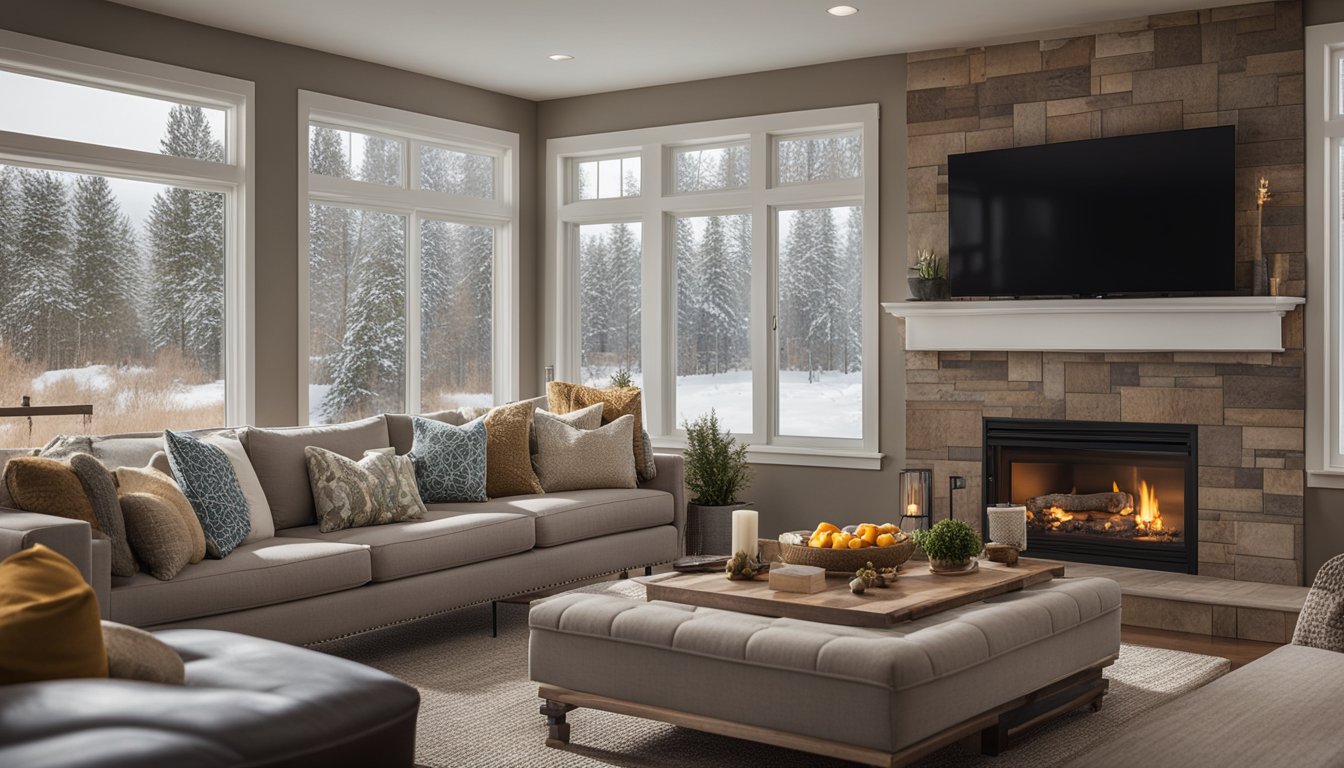Late updated: 29 Jul 2024 13:07
Written by: Eleanor Hartman
Ways To Reduce Energy Bills This Winter: Effective Tips and Strategies
Winter can often mean a spike in our energy bills as we strive to keep our homes warm and comfortable. There are practical and effective ways we can reduce energy costs while maintaining a cosy environment. Simple adjustments like enhancing home insulation and using energy-efficient appliances can make a significant difference.

Another key strategy involves optimising our heating systems with smart technology. Using a programmable thermostat allows us to control heating times, ensuring the house is warm only when needed. This small change can lead to substantial savings on our bills and is an investment worth considering.
For those keen on more tips, we also examine common questions and concerns about reducing energy usage. By making informed choices, we can save money while contributing to a more sustainable lifestyle.
Key Takeaways
- Enhance home insulation to keep heat in and reduce energy costs.
- Use smart heating technology to optimise energy usage.
- Make informed choices to save money and improve energy efficiency.
Optimising Home Insulation and Weatherproofing
Reducing energy bills in winter involves ensuring that your home is well-insulated and weatherproofed. Key areas to focus on include adding insulation to important parts, sealing air leaks, and implementing effective window treatments.
Insulating Key Areas
Proper insulation is critical for maintaining a comfortable indoor temperature and reducing energy usage. The attic is a primary focus; adding insulation here can prevent heat from escaping, reducing the workload on your furnace.
Walls and floors also benefit from added insulation, helping to retain heat. Insulating basement rim joists and crawl spaces can prevent cold air from seeping in. Energy Star recommends ensuring existing insulation is up to standard and filling any gaps.
Ductwork should not be overlooked. Sealing and insulating ductwork helps in preventing energy losses. Any gaps or unsealed joints in the ductwork can lead to significant heat loss, elevating energy bills.
Weatherstripping and Sealing Air Leaks
Weatherstripping doors and windows is essential to combat drafts. We can apply self-adhesive foam or rubber weatherstrip to doors and windows to create a tight seal. This prevents warm air from escaping and cold air from entering.
Caulking is another effective method. We should seal gaps and cracks around windows, doors, and utility cutouts with caulk. This includes checking for air leaks in attics, basements, and around ductwork.
Paying attention to drafts around outlets and switch plates on exterior walls is also important. Inserting foam gaskets behind these plates can help in reducing drafts and improving overall insulation.
Window Treatment Strategies
Windows are significant sources of heat loss. Installing heavy or thermal curtains can help retain heat within a room. We can also consider cellular shades, which provide insulation through their honeycomb structure.
Another effective strategy is using plastic window kits. These kits add an extra layer of insulation by trapping air between the plastic and the window, reducing drafts.
Applying weather-resistant film on windows can further minimise heat loss. The aim is to maintain interior warmth while reducing the reliance on heating systems, directly impacting energy bills.
By implementing these insulation and weatherproofing measures, we can ensure our homes stay warm and energy-efficient throughout the winter months.
Smart Heating and Energy Use Management

To manage our energy consumption effectively this winter, we need to focus on using heating systems efficiently, integrating energy-efficient appliances, and adopting smart energy-saving practices. These strategies can help us reduce energy bills while maintaining comfort in our homes.
Efficient Heating System Utilisation
Utilising our heating systems efficiently is vital for reducing energy bills. Installing a programmable thermostat or a smart thermostat enables us to set precise heating schedules. By lowering the temperature when we're away or asleep, we can significantly cut down on heating costs.
Ensuring our furnace and water heater get routine maintenance, such as changing filters and inspecting for issues, ensures they run at optimal efficiency. Heat pumps can also be a cost-effective alternative, offering heating and cooling from a single unit. Using curtains and drapes to trap heat from the sun during the day can further reduce dependence on artificial heating.
Energy-Efficient Appliances and Lighting
Investing in energy-efficient appliances is another key step. ENERGY STAR certified appliances like fridges, freezers, and dishwashers consume less electricity. Using LED light bulbs instead of traditional incandescent ones can greatly reduce lighting costs since LEDs use less energy and last longer.
An energy audit can help identify which appliances are consuming the most power. Limiting the use of energy-intensive appliances such as ovens and considering cold water laundry can also cut down on energy consumption. Additionally, unplugging electronics or using power strips to prevent energy vampires (devices that consume power even when off) is a simple yet effective practice.
Adopting Energy-Saving Practices
Smart energy-saving practices can lead to considerable savings. Simple actions, like wearing warmer clothing and using blankets, can allow us to keep indoor temperatures lower. Minimising the use of oven by cooking multiple dishes at once, or using a microwave instead, conserves energy.
We can also program our smart thermostats to adjust temperatures automatically based on our daily routines. Setting reminders for regular maintenance for all heating systems ensures they run efficiently throughout the season. Personal habits such as closing doors and windows properly to prevent drafts, and turning off lights when rooms are unoccupied, play a crucial role in reducing our overall energy bills.
Allowing sunlight to naturally warm our living spaces during the day, engaging in energy-efficient laundry practices, and utilising appliances wisely are straightforward yet impactful methods to manage energy use efficiently.
Frequently Asked Questions

During the winter months, conserving energy and reducing heating costs can be a pressing concern. Below, we address common questions on how to effectively manage and lower energy bills.
How can one lower their electricity bill during winter in a flat?
To cut costs, we can start by using programmable thermostats to regulate temperature settings when we're not home. Sealing gaps around doors and windows can also prevent heat loss. Utilising energy-efficient appliances and LED lighting helps reduce electricity consumption further.
What are effective measures to save on heating costs throughout the winter season?
Regular maintenance of heating systems, including cleaning or replacing filters, ensures efficiency. We should also consider layering clothing and using blankets to stay warm instead of solely relying on heating systems. Insulating our homes properly, using draft stoppers, and closing curtains at night traps heat inside.
What are the top strategies for Canadians to reduce their utility bills?
Canadians can benefit from sealing ducts and improving insulation in attics and basements. Smart thermostats that adjust temperatures based on occupancy patterns are highly effective. Leveraging off-peak electricity rates for high-energy chores like laundry and dishwashing can provide additional savings.
Which methods can Canadians adopt to use less energy?
We can minimise energy use by unplugging electronic devices when not in use and using power strips to manage multiple devices. Adopting energy-saving habits, such as turning off lights when leaving a room and taking shorter showers, contributes significantly. Investing in solar panels can also offer long-term reductions in energy consumption.
How do I understand the reasons behind high electricity bills in winter, even with gas heating?
Increased electricity consumption from lighting, electronics, and appliances often drives up winter bills. We use more indoor lighting due to shorter daylight hours. Additionally, electric heaters and holiday decorations can add significant costs. Monitoring our usage through energy audits or smart meters can provide insights into specific areas of high consumption.
In what ways can one cut down on their electric bill drastically?
Installing energy-efficient windows and doors greatly reduces heat loss. We can also use ceiling fans to distribute warm air more evenly throughout rooms. Adopting a mix of renewable energy sources, such as solar and wind, can reduce reliance on traditional power grids and lead to substantial savings.